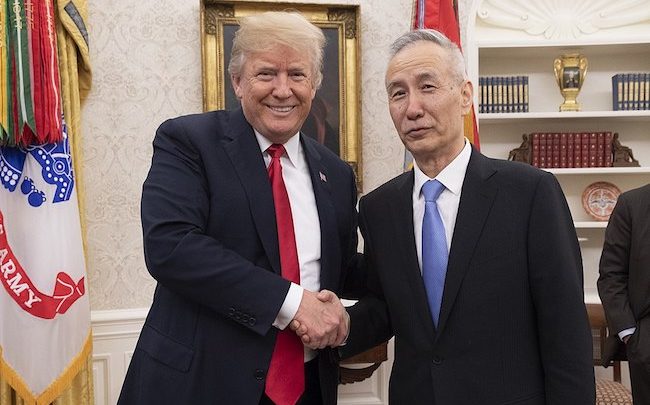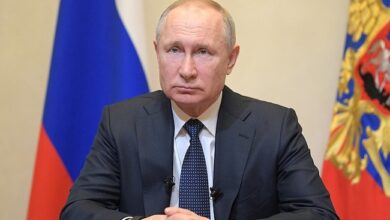Implications of the escalating China-US trade dispute
If allowed to escalate, the trade dispute between China and the United States will significantly increase the likelihood of a global protectionist surge and a collapse in the rules-based international trading system. Here the author assesses the specific impacts on the Chinese and US economies, as well as the strategic problems this dispute poses for Europe.

By Uri Dadush
President Trump’s decision to increase tariffs from 10% to 25% on $200 billion-worth of imports from China, and his threat to do the same to the other $300 billion-worth of US imports from China which have not been penalised so far, marks a new and dangerous phase in the deterioration of international trade relations since his election in 2016.
China has just announced retaliation on $60 billion-worth of imports from the United States, a relatively mild response. The new tariffs raise three questions of general interest and more specifically for the EU: what will be the effect on the American, Chinese and, ultimately, the European economy? What are the implications for the multilateral trading system? How should Europe adjust its geopolitical stance vis-à-vis its two largest trading partners?
Direct Economic Effect
From the outset, it should be noted that the negotiations between China and the United States could still lead to a win-win outcome. Reformers in China know that their state-owned enterprises are inefficient, subsidies are costly, capital is mis-allocated, and the nation’s surging endowment of intellectual property must be protected. All these reforms are in the direction many American businesses and the moderates in the United States administration want to see. Both countries need and want a deal and the situation is fluid. Negotiations are expected to resume, with Presidents Trump and Xi Jin Ping scheduled to meet in Tokyo at the end of June.
China has retaliated but has also been quite restrained in its response to date, and the US measures could still be reversed. The situation is also fluid because the US has so far applied tariffs almost exclusively on intermediate products (capital goods and parts) imported from China. This measure penalises US producers vis-à-vis competitors across the world, discourages investment in the United States in some sectors, and so represents an unstable equilibrium. If tariffs remain, they may create strong incentives to apply tariffs on China’s consumer product exports as well.
The direct aggregate effect of the tariffs on the welfare of the US and Chinese, while negative, is likely to be very small.
It is possible to model the effect of tariffs in extraordinary detail but ultimately their direct aggregate effect on welfare is small. This is essentially because they represent a transfer from consumers, importers and partner exporters to the government imposing the tariffs, a point that President Trump has seized on and voiced repeatedly, even though he mistakenly believes that only the Chinese will pay for the tariff. One can assume that sooner or later, the American consumer will bear much of the cost of the tariff though higher prices, but also that tariff revenue will return to American residents in some form. The negative aggregate welfare effect of tariffs thus arises because, at the margin, they displace more efficient producers by less efficient ones who may be domestic or who may belong to third parties[1]. They also arise because, at the margin, tariffs artificially reduce the consumption or use of imports in favour of domestic goods or goods imported from third parties. These two effects (‘welfare triangles’, in the jargon) turn out to be very small – and especially so in the case of giant economies such as China and the United States, whose bilateral trade represents a small part of GDP, and who have abundant access to alternative third-party suppliers. This is why various estimates of the size of aggregate direct effects of tariffs tend to be in the region of 0.1 % of GDP or less.
The distributional effect of tariffs is likely to be very uneven and severely negative on some people and sectors.
The distributional effects of tariffs can be many times larger than the net economy-wide effects. In the case of the United States, for example, while the Treasury will see increased revenue, and some producers who compete with imports will gain, small companies that depend on imported parts from China are likely to be very badly affected by tariffs. Their capacity to negotiate lower prices with the Chinese or to pass on higher prices to consumers is limited, and they cannot easily and quickly find new suppliers or reorient their sales onto third markets when they face Chinese retaliation. Many such companies will be forced out of business.
Larger importers will also be adversely affected, but have more market power and resources to shift onto new suppliers and markets. US farmers who depend on Chinese markets have already been badly hurt by Chinese retaliation to the first round of tariffs and will suffer even more as the dispute escalates. All this means that the political salience of tariffs far outstrips their aggregate economic impact. Indeed, Trump’s belief that tariffs will help his large constituency in the rust-belt – whether correct or not – reinforces his protectionist bent.
Investment is Deterred by Tariff Uncertainty.
The biggest adverse effects of tariffs on aggregate economic activity is through investment. Lower investment is the natural result of the tariffs’ big distributional effects, as discussed above, and the uncertainty they engender. This effect on ‘animal spirits’ is difficult to model and impossible to quantify with precision, though many try. The extraordinary sensitivity of stock markets to trade news and their volatility is just one manifestation of this effect. The widening growth gap between the global manufacturing and services sectors evident in recent quarters is another, as is the slowdown in investment in many countries.
Although it is happening in an entirely different context, the slowdown of the British economy – weighed down by the lack of clarity about the trade regime after Brexit – is another example of the effect that (potential) tariffs can have on economic growth.
It is important to note that in trade as in military matters skirmishes can turn into battles and battles can turn into war. The skittishness of investors reflects the fear of extreme outcomes that could entirely disrupt global supply chains, as well as that of their progressive deterioration. The uncertainty over tariffs is most damaging when it calls into question not only domestic conditions but the viability of the global trading and investment system, to which I now turn.
Systemic Effect
If allowed to escalate, the trade dispute between China and the United States will significantly increase the likelihood of a global protectionist surge and a collapse in the rules-based international trading system, for which the beleaguered World Trade Organization provides the bedrock.
Even prior to the events of recent days, great damage has been done to the WTO by the United States’ refusal to replace members of the Appellate body, by its decision to impose tariffs on aluminium and steel for its allies (invoking national security), and by its use of Section 301 to proclaim a first round of tariffs against China – in clear violation of WTO rules.
I do not know the content of the various negotiating drafts between China and the United States, but what is certain is that the ‘deal’ is one-sided, in that China has to make big changes while the United States makes a few if any beyond – sooner or later – removing the tariffs it has imposed.
What is also clear is that negotiations are being conducted outside the WTO framework for settling disputes and that widely reported measures included in the draft agreement – such as Chinese promises to buy more soybeans, natural gas, and aircraft from the United States – would violate the non-discrimination principle of the organisation. The United States is also widely reported to insist on maintaining tariffs against China as a measure to ensure compliance with the agreement, which would also violate the WTO rules. By agreeing to negotiate in this way, China and the United States undermine the organisation that many expect them to lead.
Anyone who has worked on trade policy knows that, while many recognise that trade benefits consumers and enhances productivity, protectionist and free-trade interests are typically quite evenly balanced in countries across the world. The examples of the United States – stakeholder of reference in the rules-based system – raising tariffs, and of China – the world’s largest trader after the European Union – doing the same in retaliation, all outside the WTO system, inevitably tips the balance in favour of protectionists everywhere.
Damaging as a global slowdown induced by tariff disputes may be, the greater risk confronting Europe – whose economy depends on trade – is a return to a power-based instead of rules-based trading system – as Guntram Wolff and I have argued recently[2].
Geopolitics
As many believe, the trade dispute between China and the United States is only partly about trade, and perhaps it is not even mainly about trade. Like the regional proxy-wars between the Soviet Union and the United States during the cold war, the underlying motive is not so much about a specific measure but about great-power competition. It follows, as others have predicted, that even if this trade episode is resolved amicably, confrontations will recur – and some of these are likely to unfold outside the trade arena, where they may turn out to be even more dangerous.
Europe has big economic interests in a stable and growing United States and in a stable and growing China. China is clearly headed towards being Europe’s largest trading partner in the not-too-distant future. The Chinese economy is already about as large as the US economy in purchasing-power-adjusted terms, China’s population is more than four times larger than that of the US and its GDP per capita is growing at least three times faster. It is unthinkable that Europe will want its historical alliance with the United States to lapse, but it is also unthinkable that Europe will forego its trade and investment opportunities in China. China and Europe have differences, and some of these differences mirror the trade concerns expressed by the United States, but Europe is not in geopolitical or military competition with China.
The present trade dispute between China and the United States brings Europe’s dilemma into sharp relief. How to navigate relations between its two indispensable partners? How does Europe maintain its freedom of manoeuvre on trade and on many other issues, and how does it pursue its economic and political objectives without alienating one or the other of the sparring giants? It is safe to assume that these questions will preoccupy European policymakers far into the future.
References
[1] There are also negative effects of tariffs on productivity as competition is reduced, innovation pressures moderate, and there are less opportunities for economies of scale. However, these effects take a long time to materialize and are likely to be very small since the volume of trade affected is small relative to the size of the Chinese and American economies.
[2] U. Dadush and G. Wolff “Life after the multilateral trading system”
Uri Dadush is a non-resident scholar at Bruegel, based in Washington, DC and a Senior Fellow at the Policy Center for the New South in Rabat, Morocco. He is also Principal of Economic Policy International, LLC, providing consulting services to international organizations as well as corporations. He teaches international trade policy at the School of Public Policy at the University of Maryland and a course on globalization and development in the executive education program of the Ecole des Hautes Etudes Commerciales (HEC) and the Mohammed VI Polytechnic.




